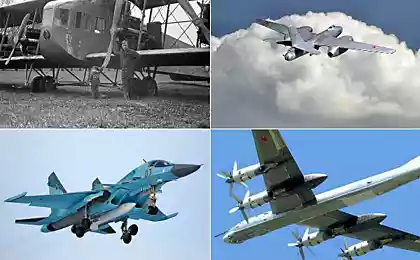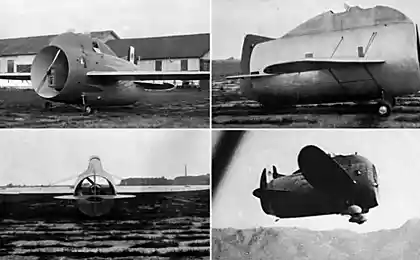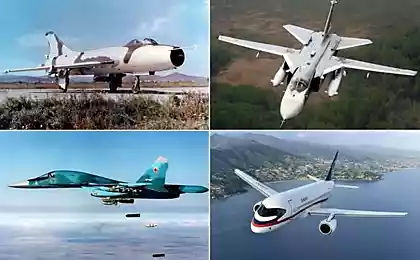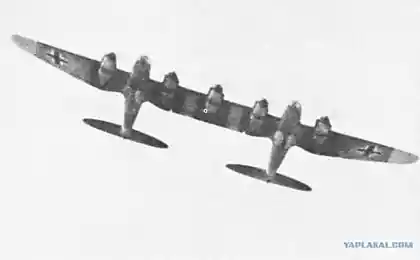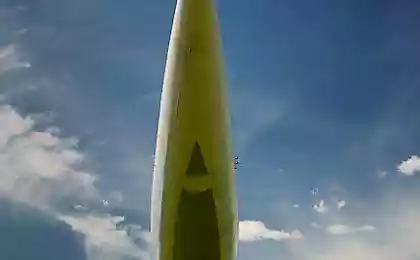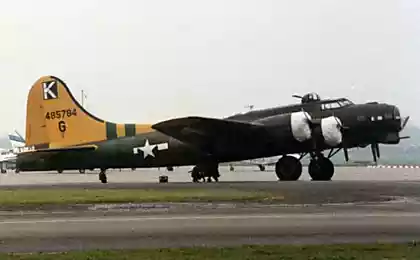1361
The world's first passenger aircraft and bomber Ilya Muromets (10 photos)
From 1913 to 1918 in Russia at the Russian-Baltic wagon factory (Russobalt) issued several series of plane "Ilya Muromets" (C-22), which was used both for peaceful and military purposes, and set a number of world records. This plane will be discussed in this article.

famous airplane aviation department was set up the factory "Russo-Balt", under the leadership of the team, led by Igor Sikorsky (in 1919 he emigrated to the United States and became famous for designing helicopters). In the creation of the aircraft was also attended by such designers as the KK Ergant, MF Klimikseev AA Serebrov, Prince A. Kudashev, GP Adler.

The predecessor of "Ilya Muromets" plane became "Russian Knight" - the world's first four-engine airplane. He, too, was designed to "Russbalte" under the direction of Sikorsky. Its first flight took place in May 1913, and on 11 September of the same year, a single instance of the aircraft was badly damaged ripped off the plane, "Muller-II» engine. Restore it did not. A direct heir of "Russian Knights" became the "Ilya Muromets", the first copy of which was built in October 1913.
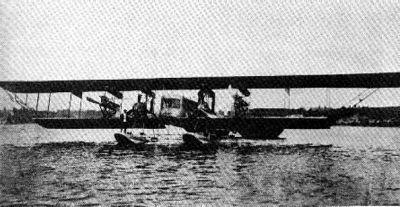
Unfortunately, while in the Russian Empire did not have their own production of aircraft engines, so the "Ilya Muromets" were delivered by German motors "Argus» (Argus) 100 hp each (hereinafter set and other types of engines, including the developed and in 1915 the Russian R-BV3).
Wingspan "Ilya Muromets" was equal to 32 m, and the total wing area - 182 m2. All the main parts of the aircraft were made of wood. The upper and lower wings are assembled from separate parts connected by connectors.

Already 12 December 1913 set the record for the aircraft payload - (the previous record was on the plane Sommer 653 kg).
A February 12, 1914 in the air was raised to 16 people and a dog, weighing 1290 kg. He piloted the plane himself I. Sikorsky. For demonstration purposes, the aircraft made a lot of flights over Petersburg and its suburbs. Crowds gathered to see an unusually large for that time aircraft. Sikorsky was sure his plane and flew over the city at low altitude for the time - just 400 meters away. While the pilots of single-engine airplanes fly over cities avoided because in the event of engine failure emergency landing in an urban environment can be fatal. On "Muromets" was found 4 engine, so Sikorsky was sure of safety of the aircraft.

Stop two of the four engines may not necessarily get the plane down. On the wings of the aircraft during flight could walk people, and it does not impair the balance of "Ilya Muromets" (exit on the wing during flight Sikorski has done himself, to make sure that, if necessary, the pilot can do repairing the engine in the air). At that time it was a completely new and makes a great impression.

It is the "Ilya Muromets" was the first passenger aircraft. For the first time in aviation history, he was separate from the cockpit interior, with bedrooms, heating, electric lighting, and even a bathroom with toilet.
The world's first high-speed long-range heavy aircraft flight was committed "Ilya Muromets" on 16-17 June 1914 from St. Petersburg to Kiev (distance flights - more than 1200 km). Also Sikorski participated in this flight are co-pilot Captain Christopher Prussis, navigator and pilot Lt. George Lavrov and mechanic Vladimir Panasyuk.
In almost a ton fuel tanks, a quarter of a ton of oil. In the event of liquidation of failures on board was ten pounds (160 kilograms) of spare parts.
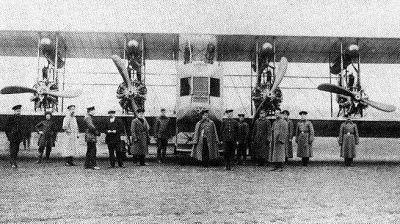
During this flight was an emergency. Shortly after take-off was made after the scheduled landing in Orsha (town in Vitebsk region), from the right engine, most likely due to the strong turbulence, the fuel hose is disconnected, resulting in the ensuing stream of gasoline engine caught fire and the flames zabushevalo. I almost died jumping out of the wing Panasyuk, who tried to extinguish the flames - he was doused with gasoline and ignited. He was saved by Lavrov, put out with a fire extinguisher, he managed to turn off the tap supplying fuel.

Sikorsky has successfully made an emergency landing, and the plane was quickly, within an hour, repaired, but because were approaching the twilight, it was decided to spend the night.
To Kiev reached without further incident. The return flight did without major emergency, but Sikorski had to go to the wing to pull the nut came loose from shaking one of carburetor engines. Return flight Kiev Petersburg was committed in one day 14 hours 38 minutes, which was a record for heavy aircraft. In honor of this event series is called Kiev.
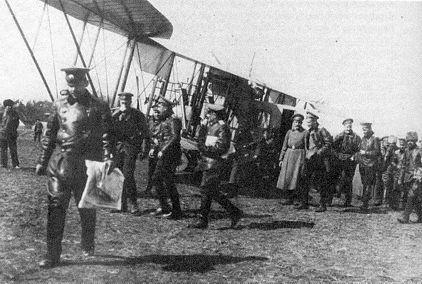
In the spring of 1914 he was issued a modification of "Ilya Muromets" a hydroplane, and until 1917 it remained the largest seaplane in the world.


famous airplane aviation department was set up the factory "Russo-Balt", under the leadership of the team, led by Igor Sikorsky (in 1919 he emigrated to the United States and became famous for designing helicopters). In the creation of the aircraft was also attended by such designers as the KK Ergant, MF Klimikseev AA Serebrov, Prince A. Kudashev, GP Adler.

The predecessor of "Ilya Muromets" plane became "Russian Knight" - the world's first four-engine airplane. He, too, was designed to "Russbalte" under the direction of Sikorsky. Its first flight took place in May 1913, and on 11 September of the same year, a single instance of the aircraft was badly damaged ripped off the plane, "Muller-II» engine. Restore it did not. A direct heir of "Russian Knights" became the "Ilya Muromets", the first copy of which was built in October 1913.

Unfortunately, while in the Russian Empire did not have their own production of aircraft engines, so the "Ilya Muromets" were delivered by German motors "Argus» (Argus) 100 hp each (hereinafter set and other types of engines, including the developed and in 1915 the Russian R-BV3).
Wingspan "Ilya Muromets" was equal to 32 m, and the total wing area - 182 m2. All the main parts of the aircraft were made of wood. The upper and lower wings are assembled from separate parts connected by connectors.

Already 12 December 1913 set the record for the aircraft payload - (the previous record was on the plane Sommer 653 kg).
A February 12, 1914 in the air was raised to 16 people and a dog, weighing 1290 kg. He piloted the plane himself I. Sikorsky. For demonstration purposes, the aircraft made a lot of flights over Petersburg and its suburbs. Crowds gathered to see an unusually large for that time aircraft. Sikorsky was sure his plane and flew over the city at low altitude for the time - just 400 meters away. While the pilots of single-engine airplanes fly over cities avoided because in the event of engine failure emergency landing in an urban environment can be fatal. On "Muromets" was found 4 engine, so Sikorsky was sure of safety of the aircraft.

Stop two of the four engines may not necessarily get the plane down. On the wings of the aircraft during flight could walk people, and it does not impair the balance of "Ilya Muromets" (exit on the wing during flight Sikorski has done himself, to make sure that, if necessary, the pilot can do repairing the engine in the air). At that time it was a completely new and makes a great impression.

It is the "Ilya Muromets" was the first passenger aircraft. For the first time in aviation history, he was separate from the cockpit interior, with bedrooms, heating, electric lighting, and even a bathroom with toilet.
The world's first high-speed long-range heavy aircraft flight was committed "Ilya Muromets" on 16-17 June 1914 from St. Petersburg to Kiev (distance flights - more than 1200 km). Also Sikorski participated in this flight are co-pilot Captain Christopher Prussis, navigator and pilot Lt. George Lavrov and mechanic Vladimir Panasyuk.
In almost a ton fuel tanks, a quarter of a ton of oil. In the event of liquidation of failures on board was ten pounds (160 kilograms) of spare parts.

During this flight was an emergency. Shortly after take-off was made after the scheduled landing in Orsha (town in Vitebsk region), from the right engine, most likely due to the strong turbulence, the fuel hose is disconnected, resulting in the ensuing stream of gasoline engine caught fire and the flames zabushevalo. I almost died jumping out of the wing Panasyuk, who tried to extinguish the flames - he was doused with gasoline and ignited. He was saved by Lavrov, put out with a fire extinguisher, he managed to turn off the tap supplying fuel.

Sikorsky has successfully made an emergency landing, and the plane was quickly, within an hour, repaired, but because were approaching the twilight, it was decided to spend the night.
To Kiev reached without further incident. The return flight did without major emergency, but Sikorski had to go to the wing to pull the nut came loose from shaking one of carburetor engines. Return flight Kiev Petersburg was committed in one day 14 hours 38 minutes, which was a record for heavy aircraft. In honor of this event series is called Kiev.

In the spring of 1914 he was issued a modification of "Ilya Muromets" a hydroplane, and until 1917 it remained the largest seaplane in the world.

